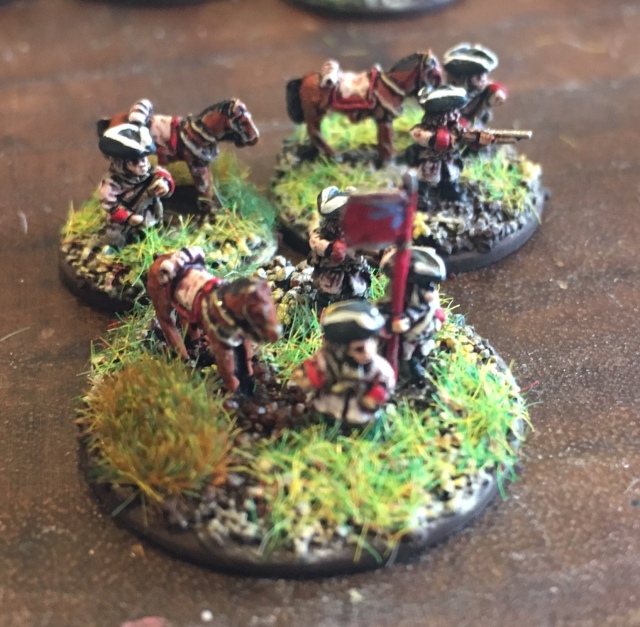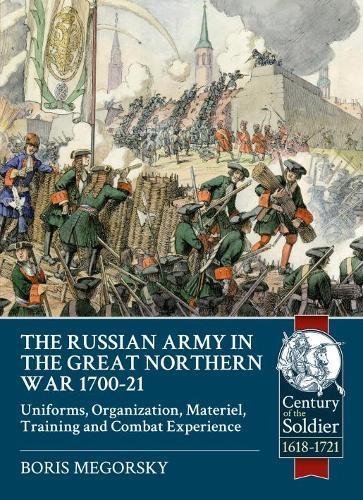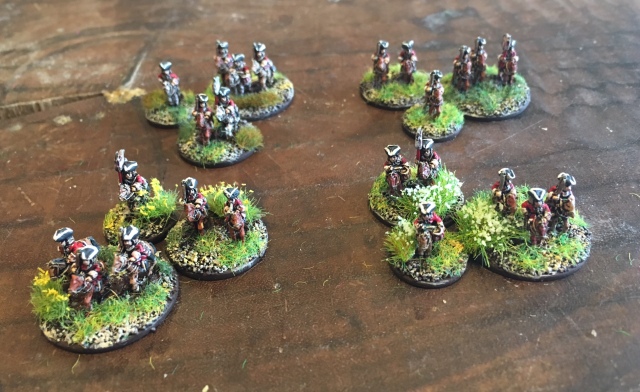
In the previous blog entry (see here) I set out the forces and the miniatures I intended to use for this project. I have just completed these units this week and hope to get a game with the Little One in the near future. Same approach as always in trying to achieve reasonable results not individual master pieces. The units I planned to do were as follows, based on some possible small encounters during the Pruth Campaign 1711.
| Ottomans | No | Pts/ unit | Total Pts | Unit Size | Total Models | Baccus Pack |
| Veteran Shot |
5 |
6 |
30 |
12 |
60 |
OTT02 |
| Trotters |
4 |
4 |
16 |
6 |
24 |
GNP05 |
| Total |
9 |
– |
46 |
– |
84 |
– |
| Russians | No | Pts/ unit | Total Pts | Unit Size | Total Models | Baccus Pack |
| Dragoons |
4 |
4 |
16 |
6 |
24 |
WSS12 |
| Forlorn Hope |
3 |
6 |
18 |
6 |
18 |
WSS03 |
| Raw Trotters |
4 |
3 |
12 |
6 |
24 |
WSS08 |
| Total |
11 |
– |
46 |
– |
66 |
– |
I am very happy with the result and I am tempted to make a small Swedish “force” from the same era (with some pikes).
Perhaps something like this.
| Swedish | No | Pts/ unit | Total Pts | Unit Size | Total Models | Baccus Pack |
| Shot |
5 |
4 |
20 |
12 |
60 |
GNS01 (Tricorne) or GNS02 (Karpus) |
| Pike |
2 |
4 |
8 |
12 |
24 |
GNS03 (Tricorne) or GNS04 (Karpus) |
| Aggressive Elite Gallopers |
3 |
6 |
18 |
6 |
18 |
GNS05 or GNS06 |
| Total |
9 |
– |
46 |
– |
102 |
– |
Sorry trying to avoid drifting, back to the Pruth stuff.
Russians
For the Russians I decided to go for units with red as a common denominator and painted them as based on units that took part in the campaign (based on a list from the draft of Nick Dorrell’s upcoming book – discussed in the previous blog, here). All these are from the “new” Baccus WSS range – I had not yet painted these but I must say that they are a joy to paint. I have so far used the old WSS range for my GNW stuff as I have a fair few of the ones lying around from previous purchases with hybric flavours.
On the subject of the Russians of this era I did notice a book currently on pre-order due out in November this year. The book is titled The Russian Army in the Great Northern War 1700-21 with the subtitle Uniforms, Organization, Materiel, Training and Combat Experience. I hope this will have some more information on uniform colours than what is currently available. Although I have to admit that I pre-ordered it based on the title, what is really interesting is the background of the author. I let you read it yourself.
Boris Megorsky was born in Leningrad, USSR in 1978. He lives in St Petersburg, Russia with his beloved wife Olga and three-year-old son Vadim. He did his PhD in Political Science and works in Human Resources, but his true passion has always been military history. As a scholar, he specializes in the everyday life of the Russian Army, its uniforms and siege warfare of the Great Northern War period; he has written dozens of articles and theses on these subjects. His book about the siege of Narva in 1704 was published in Russia in 2016 and, as a re-enactor, he is a member and sergeant of the Preobrazhensky Life Guard Regiment, 1709 ( Russia’s leading re-enactment society of the early 1700s). His passion for miniatures makes him pay great attention to details both in research and in reconstructions, be it re-enactors’ kit or graphical illustration consultations. He has consulted on a number of films, museum and publishing projects, and has worked with miniature manufacturers and artists. – From the Amazon Webpage

Here is a link to it at Amazon (but there are probably other places where you can buy it too, like the book depository). Worth having on your radar, but a long way from being out. Would of course be useful for the Pruth campaign too. Back to the key thread again.
Permski Dragoon Regiment (Dragoons)
The Permski dragoon regiment were present in the 1711 campaign so I decided to make my dragoon units represent a detachment from this regiment. They had white coats with red cuffs. I have already painted some of these for the Lesnaya Battle but they are based on 60 by 30mm bases. As these represents the Dragoon in the traditional role of being more mounted infantry than cavalry they have been based with unmounted figures but with a horse present on each base. I have used the 1-2-3 system (shown in the Pikeman’s Lament rulebook), modified to fit the 6mm scale, and as discussed in this blog entry if you do not have the book at hand.
4 units of 6 dragoons, based with the 1-2-3 method (15mm, 20mm and 25mm bases)

Repnin’s Grenadiers (Forlorn Hope)
I painted these to represent Repnin’s Grenadiers that had red coats with (speculative?) blue cuffs. Named after the Russian General, and eventually Field Marshal, Prince Anikita Ivanovich Repnin who commanded one of the Russian centre commands at Poltava in 1709 (you can read more about him here). These were also based with the 1-2-3 system.
3 units of 6 Forlorn Hope, based with the 1-2-3 method (12mm, 15mm and 20mm bases).

General Sheremetev’s Dragoon Squadron (Raw Trotters)
For these I wanted them to represent General Sheremetev’s Squadron, I painted them with red coats and white cuffs. Potentially these could be classified as non-raw (or even Veteran) assuming that the General’s squadron may be more potent than the standard dragoon unit. Boris Sheremetev commanded the overall centre at Poltava in 1709 and led the main army in the Pruth Campaign (more about him here).
4 units of 6 trotters, based with the 1-2-3 method (15mm, 20mm and 25mm bases).

The Ottomans
I do not have a lot of information of who wore what for these units – so I did a quick decision to paint them based on a basic livery green (green ink on the clothing and then picking out some detail with Livery Green). Finally got to use this fine Colour!

I would be very keen to get some comprehensive information on detailed organization and uniform guides from this conflict – but until then artistic freedom will do. I you have any views or suggestions please do let me know through the contact option on the blog of find us on facebook and ask away.
Janissaries (Veteran Shot)
I painted these in a green coat with the traditional white headgear with some simple pink detail/ There is a little story about how models were developed by Master 6mm painter Dr. Mike also known as Cranium (here). He is the man who runs the SMS (Small Model Soldier) painting clinics at various shows, teaching people how to paint “something so small”. I developed most of the techniques I am using in painting 6mm from reading his entries on the old Baccus forum (I do not find these anymore) – my favourite is the use of Windsor & Newton Ink (Nut Brown) after the painting is done – the army painter quick shade equivalent for smaller scales (kind of!) . It really makes the models “look better than they are”, in my opinion. Try it for yourself – go nuts!

5 units of 12 Veteran Shot, based with the 1-2-3 method (12mm, 15mm and 20mm bases).

Sipahi (Trotters)
Again a green colour scheme with bronzed helmet. I painted the flags green with three crescents as I had seen this for an Ottoman unit many years ago at a wargames show and liked it. Having done some research I am not 100% sure it is a valid flag for the Ottomans – but I like it so it stays until I have better alternative. The bronze helmets also looks good and, like the pink and white on the Janissaries, show that these uniforms where not designed to blend into the countryside but to look stunning!
4 units of 6 trotters, based with the 1-2-3 method (15mm, 20mm and 25mm bases)

Hope that was of some interest, another read of the rules and we have to hit the table with these. Not the same splendor as individual 28mm bases for skirmish, but it works for me. The fact that I have produced two opposing forces of almost twice the recommended starting size in a week of hobby-time is perhaps the biggest advantage.
I did a similar project for the Men Who Would be Kings rules that you can find information about (here, here and here).
Next week I will be showing some progress on the main project (a proper large battle). As the package with models came through from Marching in Colour last week (see here) and I have started slowly getting my act together again this week (afterthought – as if it ever was there!).
I have decided to give the Mutant 1984 project a break over the Summer – I did paint the two little structures/buildings I did a few weeks back (here) and showed them on the Facebook page. For completeness I include them here as well. I think we are getting closer to having the terrain we need for a proper game with these rules. I am excited to start a campaign with some Pyri Commonwealth Soldiers – The recollections of rifleman Crocodylus. However there is something rather therapeutic in doing some terrain so perhaps there will be some pieces done in the background of everything else.


The picture below shows the good Rifleman Crocodylus himself next to to one of the 6mm Dragoon bases above and a BIC pen for size comparison, as I occasionally get questions about this through the site. The Rifleman is a converted Warlord 95th rifle model (28mm scale) with a head from a crooked dice model.

/ Take care












Very impressive ! Great to see 1,2,3-basing with 6 mm minis ,!!!
Will you use cm instead of inch for the games? Suppouse a 60×60 table would work if so.
Looking forward to see the AAR from your first game.
LikeLike
Thanks, will try to get a game in. If the weather is crap this coming weekend then perhaps!. I will use CMs, and yes the table will be very small indeed.
LikeLike
Pingback: Pruth Campaign Skirmish Action in 6mm using Pikeman’s Lament – Part 3: First Game – Roll a One
Pingback: Towards Moscow Trilogy (TMT) – Horka 1708 – Russians and the Field of Battle, GNW Stuff and Podcasts – Roll a One
Pingback: GNW Horka 1708 update, Tiny Tin Troops, 2nd Edition Saga and Helion Books – Roll a One